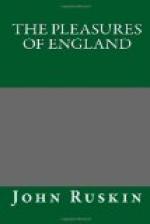[Footnote 30: ‘Fors Clavigera,’ March, 1871, p. 19. Yet read the preceding pages, and learn the truth of the lion heart, while you mourn its pride. Note especially his absolute law against usury.]
That death, 6th April, 1199, ended the advance of England begun by Alfred, under the pure law of Religious Imagination. She began, already, in the thirteenth century, to be decoratively, instead of vitally, religious. The history of the Religious Imagination expressed between Alfred’s time and that of Coeur de Lion, in this symbol of the Lion only, has material in it rather for all my seven lectures than for the closing section of one; but I must briefly specify to you the main sections of it. I will keep clear of my favourite number seven, and ask you to recollect the meaning of only Five, Mythic Lions.
First of all, in Greek art, remember to keep yourselves clear about the difference between the Lion and the Gorgon.
The Gorgon is the power of evil in heaven, conquered by Athena, and thenceforward becoming her aegis, when she is herself the inflictor of evil. Her helmet is then the helmet of Orcus.
But the Lion is the power of death on earth, conquered by Heracles, and becoming thenceforward both his helmet and aegis. All ordinary architectural lion sculpture is derived from the Heraclean.
Then the Christian Lions are, first, the Lion of the Tribe of Judah—Christ Himself as Captain and Judge: “He shall rule the nations with a rod of iron,” (the opposite power of His adversary, is rarely intended in sculpture unless in association with the serpent—“inculcabis supra leonem et aspidem"); secondly, the Lion of St. Mark, the power of the Gospel going out to conquest; thirdly, the Lion of St. Jerome, the wrath of the brute creation changed into love by the kindness of man; and, fourthly, the Lion of the Zodiac, which is the Lion of Egypt and of the Lombardic pillar-supports in Italy; these four, if you remember, with the Nemean Greek one, five altogether, will give you, broadly, interpretation of nearly all Lion symbolism in great art. How they degenerate into the British door knocker, I leave you to determine for yourselves, with such assistances as I may be able to suggest to you in my next lecture; but, as the grotesqueness of human history plans it, there is actually a connection between that last degradation of the Leonine symbol, and its first and noblest significance.




